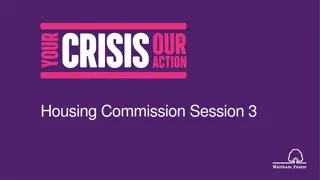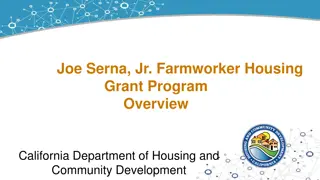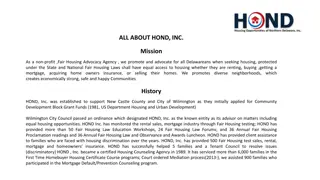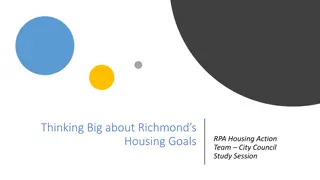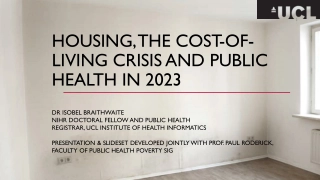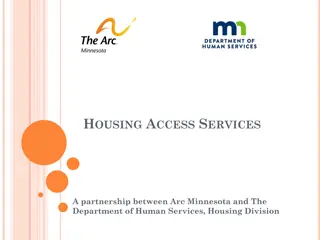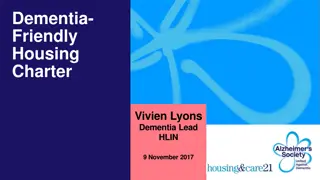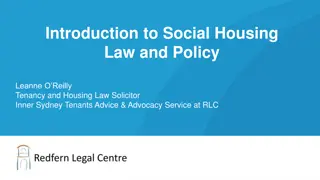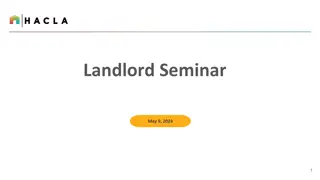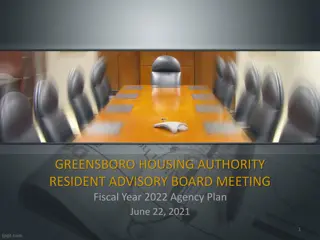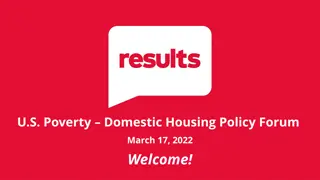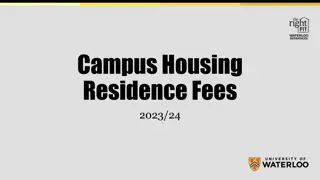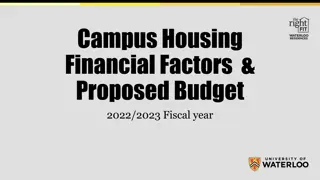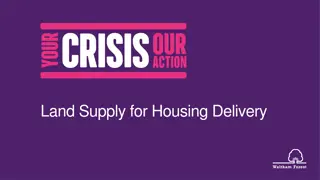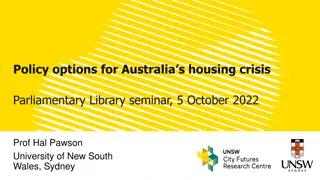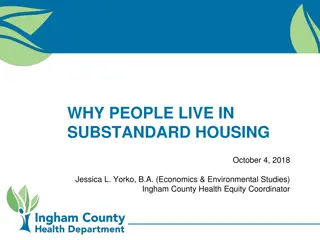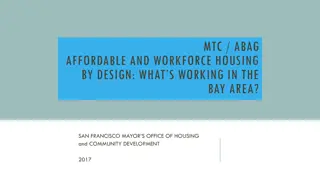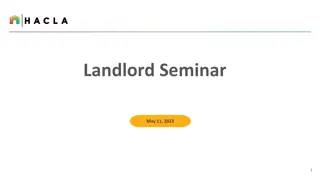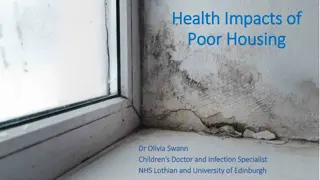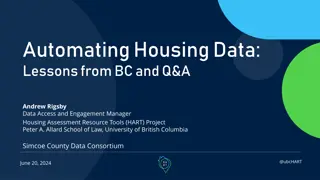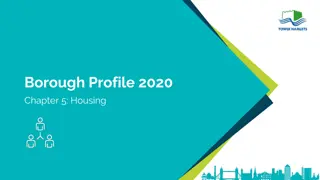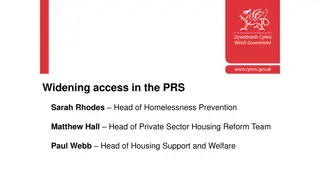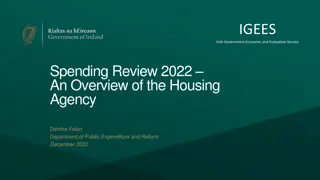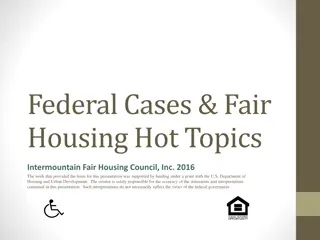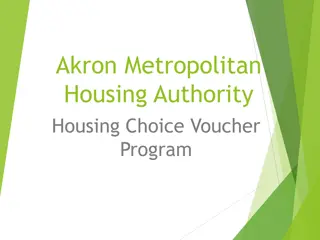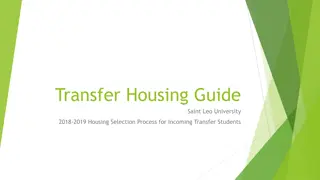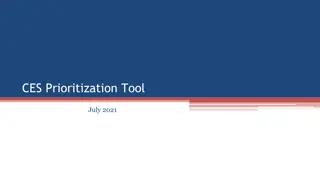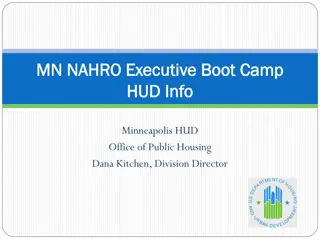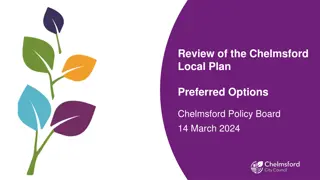Evolution of Suburbanization and Housing in Postwar America
Explore the historical shift towards suburban living in postwar America, driven by factors such as the desire for the suburban ideal, technological advancements, and government policies. Learn about the emergence of suburbs, the role of the Federal Housing Administration, discriminatory housing practices, and their impact on housing inequality.
Download Presentation

Please find below an Image/Link to download the presentation.
The content on the website is provided AS IS for your information and personal use only. It may not be sold, licensed, or shared on other websites without obtaining consent from the author. Download presentation by click this link. If you encounter any issues during the download, it is possible that the publisher has removed the file from their server.
E N D
Presentation Transcript
Suburbanization, Housing and Inequality in Postwar America Modified from a presentation given by Andrew R. Highsmith Professor of History, UC Irvine
The Emergence of a Suburban Nation Suburbanization: one of the most significant migrations in modern U.S. history * Suburbanization also included businesses, manufacturers, etc. moving into these areas Suburbs started to develop in early 20th century due to: separation of work and home new technology (streetcars, etc.) desire for the suburban ideal (home, family, etc.) fears of crime, disease, etc. in urban spaces
Suburbs and Government Action Federal Housing Administration (FHA)- part of New Deal s National Housing Act of 1934 Veteran s Administration (1944) - aka G.I. Bill furthers government role in Housing Racially restrictive housing covenants grow in 1930s and 1940s, excluding African Americans and other minority groups from purchasing homes Supreme Court declares these unconstitutional in Shelley v. Kraemer (1948)
Example of a portion of a restrictive housing covenant from the Innis Arden neighborhood in Seattle, Washington, 1941
The Great Depression and WWII 1930s severe housing shortages; widespread home foreclosures and property abandonment, thousands of bank failures slows home lending National Housing Act of 1934 Federal Housing Administration created as part of FDR s New Deal to address housing concerns FHA provides mortgage insurance on selected home loans, making home ownership a possibility for millions more Americans
The FHA and Suburbanization 1935-1974: three-fourths of FHA mortgages were for new homes; nearly all located in suburbs (few FHA mortgages in city limits) FHA favors loans with restrictive zoning, large lot sizes, and low density developments (single unit homes favored over multiple unit housing or apartment housing - Since 1934, the FHA and HUD have insured over 34 million single family home mortgages and 47,205 multifamily project mortgages. Currently, the FHA has 4.8 million insured single family mortgages and 13,000 insured multifamily projects. Source: wikipedia) Strict racial segregation in many areas; gov t public housing projects were also usually segregated by race; discrimination documented in lending practices against single women, gays and lesbians.
Redlining FHA saw integration as a threat to property values and neighborhood stability If a neighborhood is to retain stability, it is necessary that properties shall continue to be occupied by the same social and racial classes. (FHA Underwriting Manual, 1936) Racially restrictive housing covenants and redlining (refusing loans to high risk areas) meant from 1946-1959 African Americans receive less than 2 percent of FHA-backed loans
Residential security (redlining) map for the Flint, Michigan metro. area, 1937. Blue areas were seen as the most desirbale while red areas were seen as the least desirable
Levittown (Source: The Fifties, History Channel) Arichitectural (but not racial) equality https://www.youtube.com/watch?v= ZFprQDL75pE
Mapping Housing Inequality https://dsl.richmond.edu/panorama/redlining/ Select the map and area description for Los Angeles Choose 2 neighborhoods in the Los Angles area with 2 different colors (1 green for best and 1 red for hazardous ) and explain why the neighborhoods received the ratings they did. (hint: Did the color of the lines connect to race, income or other factors?) Report back in 5-10 mins.
Housing Policies and Civil Rights Postwar Civil Rights movement challenges racial inequalities in education, business practices, etc. 1968: Fair Housing Act: Outlawed discrimination in sales, financing, and rentals of homes; open housing legislation also passed in many states (NOTE: in 1964 CA voters passed Prop 14 by a 65-35% vote, which allowed property owners to rent to whomever they wanted; it was declared unconstitutional by the Supreme Court in 1967 for violating the 14th Amendment s equal protection clause) 1970-1980: number of African Americans in suburbs increases by 50 percent after this law. EX: Ladera Hights outside L.A. (73% black in 2010) However ..persistence of racially concentrated metropolitan and suburban areas.
Case Study: 1973 FBI Investigation into Donald Trump and Housing Discrimination Donald Trump (age 27) and his father, Fred, in 1973 at Trump Village, in Queens, New York City. (Source: NY Times)
The Quest for Urban Renewal Post-WW2 desire for the reorganization of metropolitan areas nationwide The Second Great Migration of African Americans from the South and mass suburbanization were simultaneous migrations taking place in mid-20th century As suburbanization acceleerated, popular perception that cities were failing/decaying grew: Man of Action (1955, Source: American Council to Improve our Neighborhoods)
Urban Renewal in Postwar America Making cities more appealing Goal: to modernize the metropolis/urban area Slum clearance disproportionately targeted black and Latino neighborhoods (EX: Bronzeville in Chicago, Bronx in NYC) Eminent domain: state s power to seize private land for public use Federal Housing Acts of 1949 and 1954 federal funding for public housing and urban renewal EX: Battle of Chavez Ravine: Dodger Stadium and Urban Renewal Video : How do slums , blight , public housing and urban renewal apply?
Dodger Stadium and Chavez Ravine (1949-1959) Police forcibly remove Aurora Vargas, daughter of Manuel and Abrana Arechiga, from her Chavez Ravine Home (1959).
The Mixed Legacy of Urban Renewal $35 billion in private investment in central cities after urban renewal projects begin Contradiction between Urban Renewal and FHA policies to expand housing Urban Renewal reduces housing stock in primarily African-American and Latino neighborhoods Through urban renewal office towers, sports stadiums (like Dodger Stadium in L.A.) and industrial parks (like in Pittsburg) have often replaced housing







